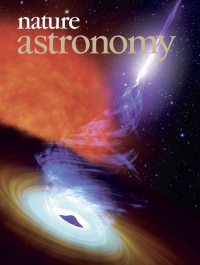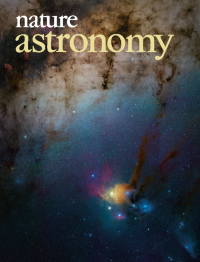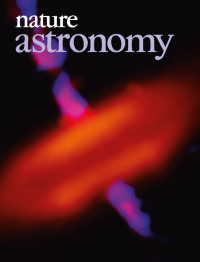Volume 1
-
No. 12 December 2017
Optical jet lagAn artistʼs impression of a black hole accreting matter from a companion star (red) launches a jet of hot plasma (purple), funnelled by swirling magnetic fields. Measurements of a lag between optical and X-ray emission reveal the characteristic elevation where the jet becomes optically thin (white), giving insight into the physics of plasma acceleration.
See Gandhi et al. 1, 859–864 (2017)
-
No. 11 November 2017
Nanoflares as coronal heatersX-ray measurements of active regions of the Sun, taken by the FOXSI-2 sounding rocket, reveal very energetic X-rays — a signature of hot plasma above 10 million kelvin. As this region does not show any visible flaring activity, the results suggest that nanoflares could be the source of coronal heating.
See Ishikawa et al. 1, 771–774 (2017).
-
No. 10 October 2017
Plutoʼs varied terrainPluto displays a remarkable variety of geological processes, many of which are unique. Features captured by New Horizons include jagged mountain peaks abutting both a large putative icy volcanic structure (∼4 km high and 150 km across) and smoother nitrogen ice plains.
See Olkin et al. 1, 663–670 (2017)
-
No. 9 September 2017
The Cassini mission has revolutionized our understanding of the Saturn system. This pencil illustration depicts Cassini diving towards Saturn—for one of the last times—as part of the Grand Finale mission. The Cassini mission will end its 20-year odyssey of exploration by plunging into Saturn's atmosphere on September 15th, 2017.
-
No. 1 January 2017
Radio rendez-vous
Radio relics are diffuse radio sources of highly energetic cosmic rays that are found within galaxy clusters. A combined optical, radio (red) and X-ray (blue) study of a colliding pair of galaxy clusters reveals that relativistic electrons ejected from an actively accreting black hole are efficiently re-accelerated at a cluster shock to produce bright, large-scale radio emission.
See van Weeren et al. 1, 0005 (2017).












